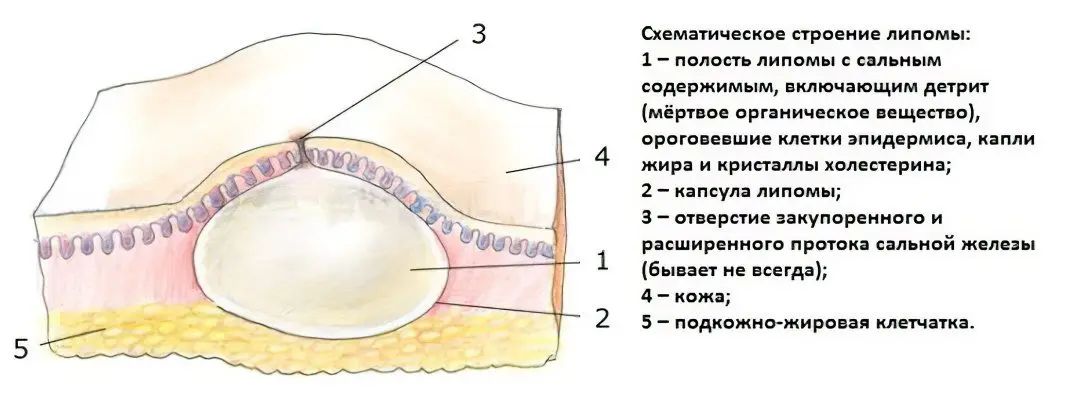
Wen is a benign painless formation with strictly defined boundaries, enclosed in a capsule of connective tissue and consisting mainly of fat cells. Strictly speaking, the word “wen” in everyday life can mean a number of pathologies related in origin and symptoms: atheroma (sebaceous gland cyst), xanthelasma (flat yellow plaque on the eyelids), milium (tiny horny cyst or “millet”), but all the lipoma is usually called a wen. This is a soft, mobile neoplasm, which has a lobular structure and is located in the subcutaneous loose tissues. Occasionally, a lipoma grows between the muscles, vascular and nerve bundles to the very periosteum. Even less common is a diffuse lipoma – a bunch-shaped accumulation of fat masses, devoid of clear outlines.
As a rule, wen are formed in areas of the body that are poor in lipid tissue: in the upper back, in the shoulder girdle, on the outer surface of the thighs and arms. Lipomas grow slowly, but over time they can reach gigantic sizes and cause significant discomfort, not to mention the aesthetic disadvantage. In very rare cases, lipomas of the subcutaneous fat are transformed into liposarcomas – malignant tumors of the connective tissue.
Outwardly, the wen looks like a rounded or oval mound. When pressed, it easily shifts to the side, and the skin on its surface can gather into a fold. Such neoplasms are almost always single (94% of cases), but with some endocrine diseases, multiple wen on the body are diagnosed.
Classification of lipomas according to localization and features of the internal structure:
Subcutaneous (the most common and simplest type);
Spilled (represents an abnormally overgrown group of lipid cells that do not have a capsule);
Perineural (surrounds the nerves, very painful, difficult to remove);
Intermuscular (grows between muscles, often recurs with incomplete removal of the capsule);
Myolipoma (formed in the thickness of the muscle tissue, rarely subcutaneous);
Angiolipoma (contains many vessels, most often localized in the kidneys, the subcutaneous type is almost never found);
Adenolipoma (includes glandular tissue, often formed in the mammary glands);
Lumbosacral (grows in the spinal canal, can compress the vertebrae, usually the result of congenital underdevelopment);
Periarticular (affects synovial bags and tendons, causes pain and movement disorders).
The size of a wen varies from a match head to large tumors that compress nerves and blood vessels. If such large wen are formed on the limbs, they can significantly limit their mobility due to impaired blood supply and muscle activity. Large wen can also cause swelling and a decrease in the sensitivity of a part of the body due to compression of nerve endings, blood vessels and soft tissues.
Since the wen grows very slowly, at the initial stage, the pathology can go unnoticed for a long time. The appearance of a lipoma is not accompanied by pain or a rise in body temperature. Occasionally, with the localization of a wen in places of contact with clothing, skin irritation and hyperthermia may occur.
On palpation of a large wen, it is sometimes possible to reveal the heterogeneity of its structure, division into lobules. In some cases, lipomatosis is diagnosed – the accumulation of many small wen. This pathology most often manifests itself on the face, although it can be found in other parts of the body.
Reasons for the appearance of a wen
Researchers of this problem consider the most accurate explanation of the nature of wen to be a violation of metabolic processes. The leading role in the development of lipomas belongs to metabolic failure, namely, the insufficiency of regulatory enzymes. The reason for this deficiency is the doubling of the long arm of the twelfth chromosome (12q13-15). There are loci of the gene responsible for the synthesis of TAG-lipase. This enzyme is needed just to break down fats into energy and water.
That is, it has been proven that wen in people grow not because of the abundant accumulation of fats in adipocytes (adipose tissue cells), for example, as a result of overeating, but because of a violation of the lipolysis process. Congenital lipomatosis is inherited by children from parents in an autosomal dominant manner and usually manifests at a young age. The proof of the metabolic theory of the origin of lipomas is the fact that they are formed in people of any physique, not only in full ones.
Additional reasons for the appearance of wen:
Diseases of the urinary system;
Endocrine pathologies (hypothyroidism, diabetes mellitus);
Hormonal imbalance.

Metabolic failures in some cases occur due to excessive consumption of foods with synthetic components. Additional risk factors are chronic tissue trauma by compression, vitamin and protein deficiency, and bad habits.
Are veins dangerous?

Malignancy, or malignancy of a wen, is extremely rare, although such a danger should not be neglected. Much more often there is such a complication as the development of an inflammatory process in the capsule of the wen. It is formed when pathogenic bacteria get inside the formation. The situation is complicated by the fact that protective antibodies are not able to penetrate the barrier created by the capsule around the wen.
When this capsule is pierced, an infection is introduced into it, a colony of bacteria quickly increases in an ideal environment for reproduction. At the same time, the volume of the wen can rapidly grow, swelling and pain appear.
Video about the characteristic features of a wen, the causes of relapses and the risk of degeneration into a malignant tumor:









